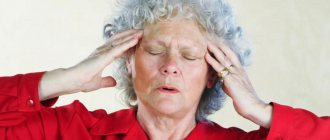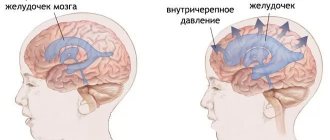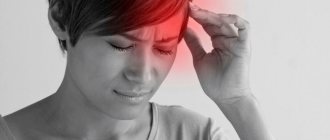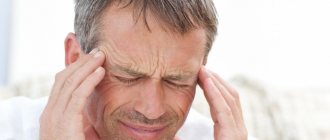Everyone has experienced headaches (cephalalgia). The cause of the occurrence can be absolutely anything: from serious disturbances in the functioning of the body to minor ones. But it is worth noting that painful pulsation in the head is a “bell” in order to go for a diagnosis.
This type of pain may indicate serious problems.
The main causes of cephalalgia
Acute pain in the head and throbbing prevents a person from living a normal life and doing business. If pain appears once, this does not necessarily indicate the presence of dysfunction in the body. In cases where a person experiences cephalalgia more and more often, and the pain lasts longer and longer, there really is a problem in the body. It needs to be eliminated, and only a specialist can handle it.
Doctors identify a number of main reasons that cause this symptom, namely:
- VSD (vegetative-vascular dystonia);
- atherosclerosis;
- sinusitis, sinusitis;
- migraine;
- eye diseases;
- hematomas;
- tumors;
- neuralgia;
- stress.
Vegetovascular dystonia
Pulsating pain is called background pain. It occurs due to a decrease in the tone of cerebral vessels, stagnation of blood, and spasms of the arteries. The difference between pain that appears due to VSD is that “jolts” do not depend on the person’s pulse.
Atherosclerosis
If a patient has problems with the vascular system, he begins to suffer from pulsation in the temporal and occipital areas of the head. But the zones can change, and the sensations can become oppressive over time.
Sinusitis, sinusitis
The reason lies in the cold you suffered, namely its complications. In order not to encounter cephalalgia, it is imperative to cure all viral and infectious diseases. The same applies to a runny nose.
Migraine
Migraine is manifested by a pulsation, which patients describe as if it were pounding right under the skin, and the pain is localized in one part of the head at the top.
Scientists have not yet proven the definitive causes of such pain, and the exact forms of manifestation of the disease have not yet been determined.
But still, there are several possible causes of migraine development, namely:
- food products (several types of cheeses and sausages);
- weather sensitivity;
- smells of ammonia, ammonia, perfume;
- serious physical activity;
- emotional outburst;
- uncomfortable body position for a long time.
A migraine can torment a person for more than one day. There are cases when the pain lasts 3 days. Most often, cephalalgia caused by this problem manifests itself in unbearably severe pain, and can go away after a few hours. Doctors note the fact that females suffer more from this.
At the end of a migraine attack, a person notes that he has severe weakness and a tendency to sleep.
Eye diseases
The following reasons that can provoke pulsation are eye diseases. A large number of people turn to specialists with complaints such as blurred vision, nausea, dizziness, photophobia, and acute pain radiating to the eye. A competent doctor will immediately determine that these are symptoms of angle-closure glaucoma - high intraocular pressure.
Cephalgia can develop due to tension in the optic nerve, which occurs due to incorrectly selected diopters of glasses or lenses. But in such cases, dizziness also appears.
Hematomas, tumors
Pulsating pain of a strong nature, which is clearly localized in one of the areas of the head, may indicate the presence of damage or a neoplasm. Also in this case, it is worth noting the presence of nausea and vomiting.
If such symptoms are noticed, you must quickly contact a specialist to diagnose a tumor or other problem and begin to treat it.
Stress
All overwork and emotional turmoil can result in severe headaches. Constant nervous tension and stress can create a “fellow traveler” for you for the whole day, namely cephalgia.
Neuralgia
Another common reason why such unpleasant sensations occur in the temple and head area. Dental problems, trigeminal neuralgia - all this provokes pain.
Other causes of cephalalgia
Osteochondrosis and a number of other problems associated with the cervical spine can provoke throbbing pain.
In winter, pulsation in the back of the head often occurs. This is explained by hypothermia and a sharp narrowing of blood vessels.
Lack of normal rest, disruption of sleep quality and routine can cause headaches.
Bad habits are also included in this list of “provocateurs”. They not only harm health, but can also cause discomfort to a person in the form of cephalgia. If a person often drank coffee and decided to abruptly stop, this can also provoke this problem, since the blood vessels are not able to return to normal so quickly.
Not everyone knows, but what we eat can also cause throbbing in our temples. These products include: chicken liver, cheeses, sausages, bacon, nuts, yogurt.
Treatment of cardiovascular diseases
Carrying out examinations will determine why the heartbeat radiates to the head, after which the doctor will prescribe treatment. For atherosclerosis, it is necessary to use complex therapy aimed not only at strengthening the walls of blood vessels, but also at normalizing blood pressure. The specialist also recommends taking medications that improve blood composition and prevent the formation of cholesterol plaques.
For pathologies of the veins or arteries, treatment is prescribed individually - much depends on the general condition of the patient and the nature of the course of the disease. It is recommended to undergo a course of drug therapy - a stroke may develop against the background of vasoconstriction. Most often, medications are prescribed to prevent the formation of blood clots.
For high or low blood pressure, it is recommended to take medications that stabilize blood pressure. With the permission of a specialist, you can supplement drug therapy with home remedies. Herbal decoctions or tinctures will help normalize blood pressure, strengthen blood vessels, and improve heart function.
Cephalgia in children
Pulsating discomfort in a child that is not accompanied by fever, cough and runny nose should alert parents. In such cases, it is important to consult a doctor. Such manifestations may indicate problems with the child’s health.
The phenomenon can be triggered by:
- disease of the vascular system;
- neuralgia;
- migraine;
- injury;
- emotional condition;
- poor nutrition;
- the presence of provoking external factors.
Cephalgia and pregnancy
Most often, girls in this position suffer from migraines, and the illness appears from physical activity, food, lack of sleep, stress, and fatigue. There are also other reasons that cause throbbing pain in women in the position:
- VSD;
- blood pressure problems;
- problems with blood supply;
- voltage;
- disorders in the brain;
- sinus inflammation;
- glaucoma.
For pregnant women suffering from cephalalgia, there are recommendations to combat discomfort, namely:
- do a light massage;
- restful sleep;
- take a contrast shower.
Regarding pain relief with medications, in this case it is important to consult a specialist, since not all painkillers are approved for pregnant women.
Methods for diagnosing pain in the left hemisphere
To determine why the left side of your head hurts, you will need a full examination. Neurologists diagnose diseases that can lead to this symptom. According to their recommendations, a number of examinations are carried out, the results of which can be informative in determining the cause of the headache and making a diagnosis:
- collecting medical history data - it is important for the doctor to know about the conditions for the occurrence of headaches, its nature and strength, as well as the patient’s lifestyle and habits, old injuries and diseases;
- Ultrasound examination of cerebral vessels (Dopplerography) is a method by which you can evaluate the speed of blood flow and the degree of filling of blood vessels;
- encephalography is a technique that allows you to examine the functional activity of the brain;
- MRI is one of the main diagnostic methods, more often used to identify tumors, but it is also informative for other pathologies.
At the Clinical Brain Institute you can undergo a full examination and determine the cause of your headache. The test results will show a complete clinical picture, on the basis of which it will be possible to select an individual treatment and prevention regimen.
Elderly age
The older a person is, the more often he suffers from throbbing pain in the head, and most often this is associated with pressure and changes in the cervical spine. But there are also a number of reasons that pose a danger to older people, and these include:
- presence of a tumor in the brain;
- presence of hematomas in the brain;
- trigeminal neuralgia;
- temporal arteritis;
- intoxication;
- presence of infectious diseases;
- stroke.
Pain in the head can also be a consequence of menopause in women, weather sensitivity, which occurs in any gender, and depression.
Causes of pain by nature and location
You can determine the cause of throbbing pain in the head by analyzing the place where the patient feels it. Sensations can move around the skull, but most often they appear in a specific part.
Pain in the back of the head
Pain in this part of the skull is characteristic of high blood pressure. It also manifests itself as a pressing character, becoming more pronounced if you turn and tilt your head. It is worth noting that such a sensation in the back of the head can warn of the development of a stroke.
But there are also such provoking factors that cause pain in the back of the head as diseases of the cervical spine, namely:
- scoliosis;
- osteochondrosis.
The pain disappears when the cause is eliminated, and with it the patient feels a relieved state in the shoulders and neck, cramps disappear, and sleep improves.
Pain on the left
Characteristic of migraine. Associated symptoms:
- visual impairment;
- disturbance of consciousness;
- dizziness;
- nausea;
- photophobia;
- loss of orientation.
Pain on the right
Pulsation of a jerking nature indicates trigeminal neuralgia. The pain affects the area of the eye, forehead, temple and jaw. In cases where the pain persists, you need to consult a doctor.
Discomfort in the temporal region
A number of diseases can manifest themselves in this way, for example:
- trigeminal neuralgia;
- migraine;
- increased blood pressure;
- intoxication;
- VSD.
Frontal region
Pain in the frontal part of the head is accompanied by convulsions, disturbances of consciousness and blurred vision. They may indicate increased intracranial pressure.
Also, pain in the forehead can be caused by sinusitis, respiratory infections and eye diseases. It may also be the result of the development of a malignant brain tumor.
Discomfort when moving your head
If unpleasant pulsating sensations in the head become more pronounced while moving the head, this may indicate diseases such as:
- neuritis;
- osteochondrosis;
- inflammation of the sinuses.
Symptoms typical for such cases are:
- nausea;
- prostration;
- dizziness;
- fever;
- partial paralysis
Patients with such complaints are promptly sent for hospitalization and treatment.
Pain and nausea
The cause of such changes in the body may be food poisoning. Throbbing in the head and nausea indicate changes in the brain or nervous disorders. The attack can also be triggered by head injuries.
Pulsation in the head without accompanying pain
The most common cause of such changes is disruption of the central nervous system or cardiovascular system.
Making a diagnosis in a medical institution
Once this problem occurs, you should immediately go to the hospital. The specialist is recommended to tell you where the pulsation is localized, at what time it appears, how often it occurs, what provokes the condition, and whether there is pain.
In most cases, timely consultation with a doctor helps to avoid unwanted consequences.
The following is prescribed as a diagnosis:
- blood and urine tests;
- Magnetic resonance imaging;
- ultrasonography;
- CT scan;
- electroencephalogram;
- angiography;
- X-ray of the cervical spine;
- fundus examination;
- consultation of highly specialized doctors.
How to quickly relieve an attack of cephalalgia
In cases where a headache does not appear frequently or systematically, and a person definitely does not have diseases that can provoke it, then you can deal with the discomfort on your own. To do this, it is not necessary to use strong medications and call a doctor.
When you feel a severe headache, forget about bad habits, such as smoking and give up alcohol. You should also not apply ice or increase the dose of the analgesic yourself unless your doctor recommends it.
There are a number of actions that need to be taken so that a person with a headache begins to feel better, namely:
- Bring fresh air into the room.
- Free the patient from tight clothing and constricting jewelry, unbutton the shirt collar and raise his legs so that they are higher than head level.
- Reduce indoor lights and sounds to a minimum.
- Give water, it can also be a decoction of soothing and relaxing plants.
- Take a warm foot bath and apply a compress to your head.
- It is necessary to warm a person in cases where the pain intensifies and there is chills.
- Lightly massage the temple area, neck, head, while the person should lie down.
If the above methods do not help within 30 minutes, and only get worse, give the patient an analgesic. If this does not help, then call the ambulance doctors.
Treatment methods
If you experience sharp pain in your heart, you must take a sitting position and unfasten your collar and cuffs. If your blood pressure is elevated and you suspect an angina attack, you should take a nitroglycerin tablet. It is also important to provide access to fresh air into the room. If symptoms do not go away after 15–30 minutes, you need to call an ambulance.
The treatment regimen is selected individually, depending on the exact diagnosis, the patient’s age and other factors. During an exacerbation of diseases, hospital treatment may be necessary, but then it is necessary to follow doctors’ orders at home. Thus, the treatment regimen may include the following steps:
- taking medications - prescribed individually, necessary for long-term use for certain diseases;
- proper nutrition - to reduce the load on the heart, you need to avoid fatty and salty foods;
- surgery - is prescribed only if there is a threat to life due to a blood clot or heart defects.
At the Clinical Brain Institute, treatment is carried out both in an inpatient and outpatient setting. At the center you can receive 24-hour medical supervision, as well as recommendations for doing it at home. The effectiveness of treatment depends on the timely use of medications, as well as proper nutrition and other factors.
When to contact a specialist
The appearance of a throbbing headache is already a “bell” that you need to see a doctor and get checked. And few people know that there are situations that oblige the patient to contact a specialist to alleviate the condition, and sometimes even save a life.
If you notice that:
- The pain lasts for more than one hour, and medications do not help.
- The pulsation becomes stronger, despite the fact that the patient does nothing.
- Pain in the occipital region appears immediately after a person wakes up or awakening occurs due to unbearable sensations that do not allow doing anything.
- A buzzing sensation is often felt in a certain area of the head.
- The pain causes dizziness, nausea, vomiting, partial paralysis, clouding of consciousness, and inability to speak normally.
- Intense pulsating beats that do not stop for several days.
- Changes in blood pressure, which are accompanied by headaches.
- The nature of the throbbing pain constantly changes.
If you notice any of the above changes, you should immediately consult a doctor or an ambulance, as serious problems may be hidden behind this.
What can you do at home?
If a person has a pulsating and noisy head, then very often folk remedies are used, which are quite effective for this condition.
At the same time, it is worth taking medications, which are considered the basis of therapy for these and similar conditions. But, if the patient suffers from these types of headaches, and there is no way to see a doctor, you can resort to one of these methods:
- Using leech saliva .
- Ginger based tea . You will need two teaspoons of ginger in any form and a liter of boiled water. It is necessary to simmer the drink over low heat for several minutes. After cooling, it is recommended to add honey or lemon to the tea. You need to drink at least twice a day.
- Chopped horseradish root is mixed with sour cream (1:1). It is recommended to take at least three times a day.
- Tea made from strawberry flowers , which can be consumed in unlimited quantities.
- Milk with iodine will help get rid of pulsation . To do this, you need to mix two drops of iodine with a glass of milk. The course of treatment is 20 days. With each dose it is necessary to increase the drops by one; on the 11th day the number of drops is reduced one by one. Break 14 days.
- Dandelions with sugar . To prepare the product, you need 2 kg of dandelions, which are poured into a three-liter container in layers with sugar. Approximately raw materials are used 1:1. The mass must be compacted at the end and hidden for three days in a dark place. The resulting syrup is taken 1 tsp. per 100 ml of liquid, no more than three times a day.
- Valerian root helps calm pulsation . For a glass of water you need to use 1 tbsp. plants. Leave for 8 hours. Drink 2-4 times a day.










